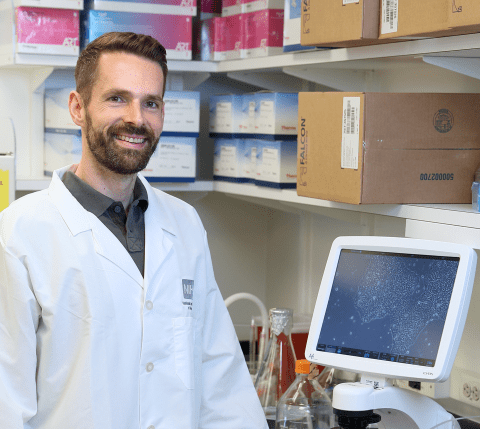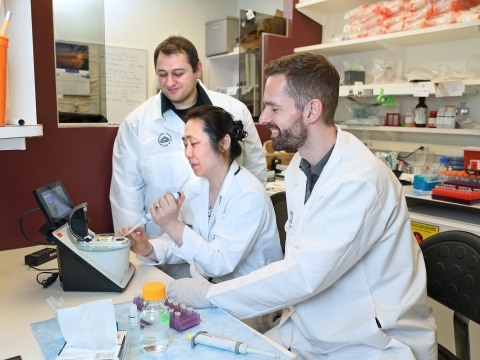Intramural scientist explores molecular pathways underlying craniofacial disorders
NIDCR’s newest on-campus investigator, biochemist Achim Werner, PhD, has long been fascinated by the inner workings of cells. He recognized that examining the vast, largely unexplored molecular landscapes within cells could fill much-needed gaps in the field. What he didn’t expect was that his line of inquiry would lead him to new insights about patients with craniofacial developmental conditions.
This quest to pursue fundamental questions in biomedical science wherever they lead—and the often-surprising breakthroughs that emerge—is core to the NIH mission and to trans-NIH initiatives such as the Earl Stadtman Investigator program. Founded in 2009, the program is designed to recruit exceptional, creative early-stage scientists—such as Werner—to intramural tenure-track positions at NIH. To enable high-risk, high-impact research, Stadtman investigators are given a lab, resources, personnel, and a budget so they can hit the ground running.
“The NIH intramural environment frees you of the pressure and distractions of grants so you can spend more time at the bench and focus solely on your experiments,” says Werner, who came to NIDCR as a Stadtman investigator in October 2017. Two new Stadtman recruits—Roxane Tussiwand, PhD, and Laura Kerosuo, PhD—will join NIDCR’s intramural research division in the summer of 2018.
Werner began studying stem cells as a graduate student in Germany and continued his research as a postdoctoral fellow at the University of California, Berkeley. His goal was to parse the delicate molecular interplays that keep stem cells alive, dictate when and whether they divide, determine the type of mature cells they ultimately become, or restrain them from growing unchecked into cancer.
Central to nearly all of these processes is the aptly named molecule ubiquitin. When one or more of these widely abundant molecules are added to or removed from a protein—in a process called ubiquitin modification—the protein’s function, location, or stability can be altered. These changes, in turn, can tweak the chain of interactions with other proteins in the cell. Depending on the outcome of these molecular cascades, a mammalian embryonic stem cell could be nudged along any number of developmental paths toward its ultimate fate. This transformative process, called differentiation, can lead to development of mature bone cells, neurons, liver cells, or other cell types. Werner was especially interested in understanding how ubiquitin modification helps to guide differentiation of embryonic stem cells into neural crest cells, which are essential to early development of the head and face.
As a postdoctoral researcher working with stem cells in culture, Werner and his colleagues “stumbled across a ubiquitin-modifying enzyme that controls neural crest cell differentiation,” he says. “To follow up, we mechanistically dissected the entire pathway and found that it works through the protein product of a gene, TCOF1, that is mutated in 90% of patients with Treacher Collins syndrome.” The condition is characterized by abnormal in utero growth of the bones and tissues of the face, which can interfere with a person’s vision, hearing, and breathing. Previous research had shown that TCOF1 is required for normal growth of neural crest cells, but scientists didn’t fully understand the underlying mechanisms.
In piecing together the chain of molecular events, Werner and his colleagues provided a larger window into the cell processes that underlie Treacher Collins syndrome. A more complete understanding of the molecular bases of diseases, especially rare diseases like Treacher Collins, will offer scientists the conceptual underpinnings needed to develop new therapies.
Now at NIDCR, Werner envisions applying this molecular dissection approach to other rare developmental diseases. He’s teamed up with intramural researchers in the lab of Daniel Kastner, MD, PhD, at NIH’s National Human Genome Research Institute. Kastner’s group studies patients with undiagnosed disorders of inflammation, some of which involve craniofacial defects. Kastner’s team recently identified one such disorder—complex multiple congenital anomaly disorder—that seems to be caused by mutations in a ubiquitin-modifying enzyme. Werner and his new research team have been working to map out how mutations in the enzyme affect cellular pathways that lead to the disease. The resulting mechanistic insight could lead to the discovery of potential therapeutic targets.
Werner cites the essential basic science value of the findings, pointing out that the results could reveal fundamental aspects of ubiquitin-dependent control of development. Such insights clearly “have merit in and of themselves,” he says. When those fundamental inquiries lead to unexpected discoveries with clinical applications, “it’s extraordinarily rewarding to see that your work could help patients and families.”



